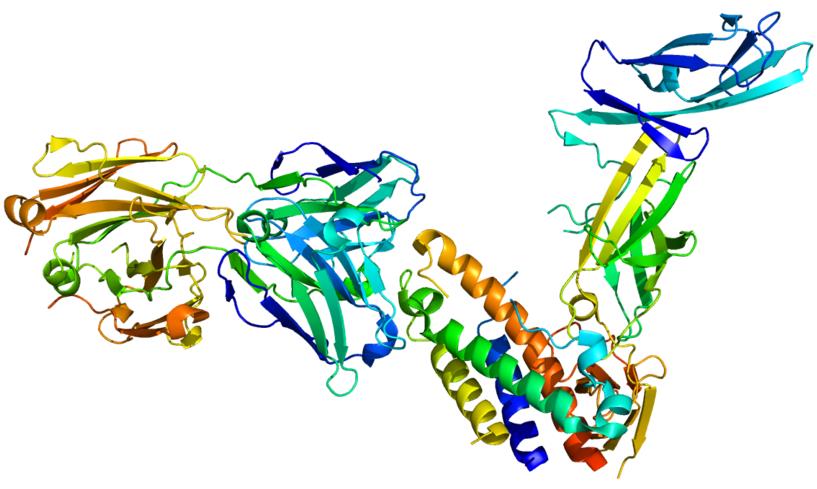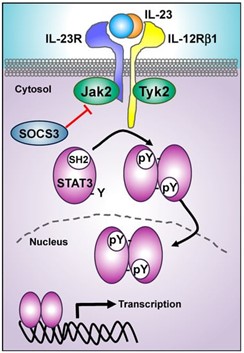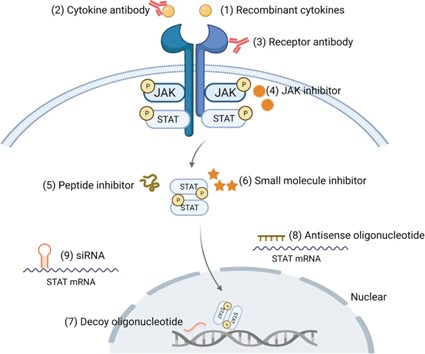Brazikumab Overview
The Introduction of Brazikumab
Brazikumab is an antibody meticulously engineered to target the cytokine IL-23A (the p19 subunit of interleukin-23), which plays an integral role in sustaining inflammatory processes characteristic of various autoimmune disorders. By binding to IL-23A, brazikumab effectively disrupts the interaction between interleukin-23 (IL-23) and its receptor complex on the cell surface, thereby thwarting the downstream pro-inflammatory signaling pathways central to the pathogenesis of Crohn's disease (CD). In a lately concluded Phase 2a clinical trial, the therapeutic efficacy of brazikumab was rigorously assessed in patients suffering from moderate to severe active CD. The findings from this study revealed not only enduring clinical benefits and high tolerability during the extended open-label phase but also immediate therapeutic effectiveness and an excellent safety profile during the initial blind phase. These results highlight brazikumab's potential as a long-term therapeutic strategy for the management of chronic inflammatory conditions affiliated with Crohn's disease and advocate for further exploration in larger and more heterogeneous patient cohorts.
Biological and Chemical Properties of IL23A
Protein Structure
 Figure 1. The Structure of Human IL23A (Wikipedia).1
Figure 1. The Structure of Human IL23A (Wikipedia).1
Protein Weight
20,730 Da
The Mechanism of Brazikumab Action
Brazikumab is a human antibody targeting the p19 subunit of IL-23, primarily employed in the rehabilitation of moderate to severe active Crohn's disease. The specific mechanism of action for brazikumab include the following steps:
Blockade of the IL-23 Signaling Pathway
As illustrated in the figure2, IL-23 is a heterodimeric cytokine that belongs to the IL-12 family and is made up of two subunits: p19 and p40. The IL-23 receptor complex, which includes IL-12Rβ1 and IL-23R subunits, is connected to Tyrosine kinase 2 (Tyk2) and Janus kinase 2 (Jak2) belonging to the Janus kinase (Jak) family. Jak2 has the ability to phosphorylate tyrosine residues in the intracellular domain of the IL-23R subunit when IL-23 binds to its receptor complex. Brazikumab binds directly to the p19 component of IL-23, preventing its interaction with the IL-23 receptor and interrupting the IL-23 signaling cascade. IL-23 is a pro-inflammatory cytokine produced primarily by activated dendritic cells, macrophages, and monocytes. Its actions are mediated by CD4 T helper subset Th17(a unique population of γ/δ T cells), natural killer T (NKT) cells, and type 3 innate lymphoid cells. Numerous chronic inflammatory disorders, such as psoriasis, multiple sclerosis, rheumatoid arthritis, and inflammatory bowel diseases, have been related to excessive IL-23 signaling. The ability of IL-23 to promote Th17 cells' and other IL-17-secreting cells' production of inflammatory mediators is primarily responsible for the pathogenic effects.
 Figure 2. IL-23 Signaling Pathway.2,3
Figure 2. IL-23 Signaling Pathway.2,3
Inhibition of the JAK-STAT Signaling Pathway
There are nine therapeutic targets within the JAK/STAT signaling pathway: (1) recombinant cytokines, (2) cytokine antibodies, (3) receptor antibodies designed to target cytokines or receptors, (4) JAK inhibitors designed to target JAKs, and (5) peptide inhibitors, (6) small-molecule inhibitors, (7) decoy oligonucleotides (ODNs), (8) antisense oligonucleotides (ASOs), and (9) siRNAs targeting STATs. Brazikumab, as a monoclonal antibody targeting cytokines, imparts its inhibitory effects through specific binding to the p19 subunits of interleukin-23. Upon engagement with its cognate receptor, IL-23 instigates activation of Jak2 and Tyk2, leading to subsequent phosphorylation of Signal Transducer and Activator of Transcription 3 (STAT3) monomers. This phosphorylation event induces dimerization of STAT3, facilitating its translocation into the nucleus where it binds to promoter regions of target genes. By disrupting the signal transduction pathways mediated by IL-23, brazikumab effectively impedes this cascade of pro-inflammatory signaling.
 Figure 3. Therapeutic Targets of the JAK/STAT Signaling Pathway.4,5
Figure 3. Therapeutic Targets of the JAK/STAT Signaling Pathway.4,5
Reduction of Pro-inflammatory Cytokine Production
The pathological consequences of excessive interleukin-23 (IL-23) signaling are intricately engaged with the promotion of various inflammatory mediators, containing but not limited to interleukin-17 (IL-17), interleukin-22 (IL-22), granulocyte-macrophage colony-stimulating factor (GM-CSF), and tumor necrosis factor-alpha (TNFα). These mediators play vital roles in the pathogenesis of numerous autoimmune and inflammatory diseases. The hyperactivity of the IL-23 signaling pathway fosters an environment conducive to chronic inflammation and tissue damage. Consequently, targeted inhibition of the IL-23 signaling pathway has emerged as a therapeutic strategy to mitigate these detrimental effects. By specifically targeting IL-23, brazikumab has been shown to effectively attenuate the production of IL-17, IL-22, GM-CSF, and TNFα. Via the interruption of the IL-23 signaling cascade, brazikumab helps in the suppression of the pro-inflammatory milieu, thereby reducing the overall inflammatory burden. This inhibition is pivotal in the management of conditions marked by excessive inflammation and offers significant clinical benefits in the treatment of inflammatory and autoimmune disorders.
Clinical Projects of Brazikumab*
| NCT ID | Study Title | Study Status | Conditions | Sponsor | Start Date |
| NCT05033431 | Study to Evaluate the Pharmacokinetics (Movement of Drugs Within the Body), Safety, and Tolerability of Brazikumab in Healthy Chinese and White Participants | COMPLETED | Healthy Participants | AstraZeneca | 2021-10-11 |
* The table is excerpted from the following website: https://clinicaltrials.gov/study/NCT05033431?cond=Brazikumab&rank=6
- Wikipedia (https://en.wikipedia.org/wiki/Interleukin_23_subunit_alpha)
- Pastor-Fernández, Gloria et al. "Decoding IL-23 Signaling Cascade for New Therapeutic Opportunities." Cells vol. 9,9 2044. 7 Sep. 2020.
- Images retrieved from Figure 2 " Decoding IL-23 Signaling Cascade for New Therapeutic Opportunities." Pastor-Fernández, Gloria 2020, used under [CC BY 4.0] (https://creativecommons.org/licenses/by/4.0/). The image was not modified and title was changed to "IL-23 Signaling Pathway".
- Hu, Xiaoyi et al. "The JAK/STAT signaling pathway: from bench to clinic." Signal transduction and targeted therapy vol. 6,1 402. 26 Nov. 2021.
- Images retrieved from Figure 5 " The JAK/STAT signaling pathway: from bench to clinic." Hu, Xiaoyi, 2021, used under [CC BY 4.0] (https://creativecommons.org/licenses/by/4.0/). The image was not modified and the title was changed to " Therapeutic Targets of the JAK/STAT Signaling Pathway".
For research use only. Not intended for any clinical use.
This site is protected by reCAPTCHA and the Google Privacy Policy and Terms of Service apply.

